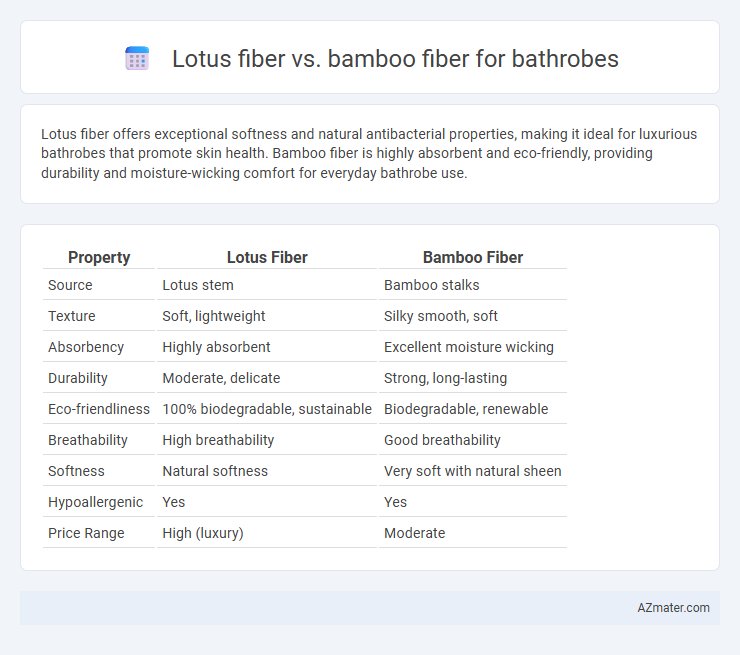Lotus fiber offers exceptional softness and natural antibacterial properties, making it ideal for luxurious bathrobes that promote skin health. Bamboo fiber is highly absorbent and eco-friendly, providing durability and moisture-wicking comfort for everyday bathrobe use.
Table of Comparison
| Property | Lotus Fiber | Bamboo Fiber |
|---|---|---|
| Source | Lotus stem | Bamboo stalks |
| Texture | Soft, lightweight | Silky smooth, soft |
| Absorbency | Highly absorbent | Excellent moisture wicking |
| Durability | Moderate, delicate | Strong, long-lasting |
| Eco-friendliness | 100% biodegradable, sustainable | Biodegradable, renewable |
| Breathability | High breathability | Good breathability |
| Softness | Natural softness | Very soft with natural sheen |
| Hypoallergenic | Yes | Yes |
| Price Range | High (luxury) | Moderate |
Introduction to Lotus Fiber and Bamboo Fiber
Lotus fiber, derived from the stem of lotus plants, is an eco-friendly textile known for its natural breathability, lightweight texture, and antibacterial properties ideal for bathrobes. Bamboo fiber, extracted from bamboo pulp, offers superior moisture-wicking, softness, and durability, making it a popular sustainable choice in luxury bathrobe manufacturing. Both fibers emphasize natural origins and sustainability but differ in texture and performance characteristics suited for different user preferences in bathrobes.
Origins and Sustainability of Lotus and Bamboo Fibers
Lotus fiber is derived from the stem of the lotus plant, traditionally harvested in Southeast Asia using a labor-intensive process that extracts long, breathable fibers ideal for lightweight bathrobes. Bamboo fiber, sourced from fast-growing bamboo grass, undergoes mechanical or chemical processing to produce soft, durable fabric known for its natural antibacterial properties and moisture-wicking abilities. Both fibers are celebrated for their sustainability: lotus fibers are biodegradable and harvested without damaging the plant, while bamboo's rapid growth and minimal pesticide needs make it an eco-friendly alternative in textile production.
Harvesting and Production Processes
Lotus fiber is derived from the stem of the lotus plant through a labor-intensive hand-harvesting and extraction process that involves soaking, scraping, and spinning the fibers, resulting in a sustainable yet costly production. Bamboo fiber is produced by mechanically crushing bamboo stalks and using enzymes to break down the plant into a viscous pulp, or chemically treating them with solvents in a lyocell process, offering a more scalable and eco-friendly method. The natural antimicrobial properties of both fibers make them ideal for bathrobes, but the environmental impact and softness vary significantly due to their distinct harvesting and production techniques.
Environmental Impact Comparison
Lotus fiber and bamboo fiber both offer sustainable alternatives for bathrobe fabrics, but lotus fiber has a lower environmental impact due to its minimal water usage and natural biodegradability. Bamboo cultivation requires substantial water and sometimes chemical processing, which can contribute to environmental pollution if not managed responsibly. Overall, lotus fiber production is more eco-friendly, supporting reduced carbon footprint and less soil depletion compared to bamboo fiber.
Texture and Softness in Bathrobes
Lotus fiber bathrobes are prized for their lightweight, breathable texture and natural smoothness, offering a unique silky feel that enhances comfort. Bamboo fiber bathrobes are known for their exceptional softness and moisture-wicking properties, providing a plush, velvety touch ideal for absorbing water after a bath. Both fibers deliver eco-friendly benefits, but bamboo tends to offer superior softness, while lotus fiber excels in breathability and a distinctive textured finish.
Absorbency and Moisture-Wicking Properties
Lotus fiber offers moderate absorbency with a natural ability to wick moisture, making it gentle and breathable for bathrobe use. Bamboo fiber excels in absorbency, often outperforming cotton, and provides superior moisture-wicking properties, ensuring quick drying and enhanced comfort. Both fibers are eco-friendly options, but bamboo's advanced moisture management makes it ideal for bathrobes requiring high-performance absorbency.
Durability and Longevity for Daily Use
Lotus fiber exhibits superior durability with high tensile strength and resistance to wear, making it ideal for daily use bathrobes that retain softness and structure over time. Bamboo fiber offers natural antibacterial properties and moisture-wicking but tends to degrade faster due to its lower abrasion resistance and fiber breakdown during repeated washing. Choosing lotus fiber bathrobes ensures extended longevity and sustained comfort, outperforming bamboo in maintaining fabric integrity through frequent use.
Comfort and Hypoallergenic Benefits
Lotus fiber bathrobes offer exceptional softness and natural breathability, enhancing comfort by regulating body temperature and moisture absorption. Bamboo fiber is highly hypoallergenic due to its antibacterial properties, reducing skin irritation and making it suitable for sensitive skin. Both fibers contribute to sustainable luxury, but bamboo's superior moisture-wicking ability often makes it a preferred choice for bathrobes prioritizing comfort and skin health.
Price and Market Availability
Lotus fiber bathrobes typically come with a higher price point due to the labor-intensive extraction process and limited raw material availability, making them a niche luxury product. Bamboo fiber bathrobes are more widely available and affordable, benefiting from mass production and the fast-growing bamboo supply. Market availability heavily favors bamboo fiber, as it is commonly used in eco-friendly textiles, while lotus fiber remains scarce and premium-priced.
Choosing the Best Fiber for Bathrobes
Lotus fiber offers exceptional breathability and natural antibacterial properties, making it ideal for bathrobes that stay fresh after multiple uses. Bamboo fiber stands out for its superior softness and moisture-wicking abilities, providing a luxurious feel and quick drying comfort. Choosing between lotus and bamboo fibers depends on prioritizing durability and eco-friendliness or softness and absorbency for your bathrobe needs.

Infographic: Lotus fiber vs Bamboo fiber for Bathrobe
 azmater.com
azmater.com